Canon EF-M 28mm f/3.5 Macro IS STM Review
Intro: A 28mm Macro?
Wow! It feels like a very long time since I’ve held a new Canon EF-M lens. Canon’s release schedule of lenses for its mirrorless system has been, ahem, rather sparse. The system launched with two lenses (Canon EF-M 22mm f/2 STM and 18-55mm f/3.5-5.6 IS STM) in June 2012, but the next lens (the very well regarded EF-M 11-22mm f/4-5.6 IS STM) didn’t arrive until 2013 (and wasn’t released in the United States until 2015), then the 55-200mm f/4.5-6.3 IS STM in 2014 (ditto on the US release), and then the 15-45mm f/3.5-6.3 IS STM in 2015. I skipped that last lens, as it held little interest for me. Four years from the release of the first M system and we still had only one prime lens…and no dedicated macro option. That finally changed in July of 2016 with the release of the lens at hand, the Canon EF-M 28mm f/3.5 IS STM. Is the 28mm Macro the lens we’ve been looking for?
Many EOS M shooters (myself included) have been clamoring for a dedicated macro lens for the EF-M for some time. In my mind it seemed logical for Canon to produce a mirrorless version of its excellent EF-S 60mm f/2.8 Macro lens, and so I was bit nonplussed by the announcement of this lens. I wasn’t ecstatic over its focal length (too short) or its slowish maximum aperture (f/3.5). I expected the lens to be optically good (all the EF-M lenses have been) and light/compact, but wasn’t particularly interested by the basic specs.
But as the details emerged on the lens my interest grew. My initial disappointments are still a factor in the final outcome of this review, but I am happy to say that Canon has managed to design a very compelling lens despite those shortcomings. It all comes down to one significant factor: innovation.
In the following video review I deliver my conclusions. If you prefer to watch your reviews, click the video below.
Build, Design, and Specifications
The basic build of the 28mm Macro is pretty much what you would expect. Canon’s design language for the EF-M lenses is very good. The lens has a sleek, modern look in an almost gunmetal finish with a knurled grip section and focus ring to break up the satin fish of the barrel. As per usual for STM lenses there are no distance markings or focus window. That may be more of a factor here than usual, as most EF-M lenses with STM are unlikely to be manually focused very much. But macro shooters are much more likely to use a manual focus ring, and having no visual indicator on the barrel of focus position may be a disappointment. Fortunately the touch screen of the M system makes selecting your exact choice of focus point easier. The knurled grip section has thrown me more than once, as it feels like it should be either the focus ring (or when the brain is switched off, a zoom ring). What it actually is turns out to be the portion of the barrel used to either retract or extend the lens for shooting (this is a retractable lens design), and this section is four times as wide as the tiny textured section on the focus ring near the front of the barrel.
The one thing that occupies any real estate in that middle knurled section is the release for the lens. It is a retractable design, which aids in it being very compact. If you don’t have the lens extended into shooting position you will get a message on the screen which says, “Set the lens to the shooting position”. The lens will not focus until you have complied. The lens extends about a half inch further out when in shooting position. There are two shooting positions. The first is simply noted with a white notch on the barrel, while the second is labelled “Super Macro”. I’ll detail the second mode more in a moment, but I will note here that this represents what I believe to be the chief engineering flaw in the lens design. The Super Macro mode has a very limited focus range (only a few inches), and so does not support full focus to infinity. The full focus range is available in the normal shooting position. The problem lies in the fact that due to the retractable nature of the lens, you must use the release switch and then rotate that middle section of the barrel to extend the lens to shoot with. The action is nice and smooth, but the real problem is that there isn’t a strong defined detent for the normal mode. It is exceptionally easy to move right past it to the hard stop…which is Super Macro mode. I missed multiple shots where I was trying to quickly get into shooting position to capture some moment only to discover that I couldn’t focus more than a few inches from the lens. Frustrating! Canon should have made the detent for the normal shooting mode (full range of focus) more definite so that you could had to purposefully (not accidentally) move beyond it to Super Macro mode. This was perhaps my single greatest frustration in real world use of the lens. The white line before the Super Macro mode represents the normal shooting position.
The 28mm Macro is both short (1.79”/45.5mm in length) and light (4.59oz/130g). While not as tiny as the 22mm f/2 lens the lens is remarkably compact and its light weight proved almost unnoticeable when packing it around. I actually climbed down a mountain for nearly three hours with it mounted on the EOS M3 carried in one hand and couldn’t have been bothered to return it to my backpack…the combo is that light.
Canon’s first few EF-M lenses had an improved build quality over their EF-S siblings, up to and including metal mounts. Canon has departed from that formula with the last few EF-M lenses, though, and while the build quality still feels a bit better than many EF-S lenses the 28mm Macro sports a plastic bayonet mount with “Made In Taiwan” subtly stamped there. Gone are the days when EF-M lenses were made in Japan. The good news is that the very light weight of the lens means that relatively little stress will be put on that mount, so it probably isn’t really a problem. Still, I always prefer seeing a metal mount. This lens is pretty close to being a “plastic fantastic” in its build.
That lightweight build contributes to it being a very useful walkaround lens…as does the focal length.
Ah yes, the focal length. My brain works in full frame, so when I heard 28mm I was immediately disappointed, as I thought moderately wide focal length and tiny working distance for macro. One of those is true (working distance), but the other is not. All lenses, including Canon’s EF (full frame), EF-S (APS-C or crop sensor), or EF-M (mirrorless APS-C) are affected by the crop factor of the body they are mounted on. Some people get confused by this and think that EF-S lenses state their “true” focal length and it is only full frame lenses that are affected by the crop factor. That’s not true. An EF-S 28mm lens or an EF 28mm lens are the same focal length (28mm), but both will be affected by the crop factor of the camera they are mounted on. The full frame lens might be mounted on a full frame body, where it will have an effective focal length of…wait for it…28mm. There is no crop factor on a full frame body, which is why it is called “full frame”.
Mount that 28mm same lens (or this EF-M lens) on a crop sensor body (Canon’s APS-C camera bodies have a 1.6x crop factor) and it has effective focal length of 44.8mm. Call it 45mm. In other words, almost perfectly equating the focal length of the human eye. This is called a “normal lens”, and there’s a reason why 50mm lenses are so popular. The applications for this kind of focal length are virtually endless, and you will probably find that it just feels “right” in many applications.
A 50mm(ish) lens with the ability to focus down as close as you could want is very, very useful. I found the 28mm Macro to be a great walkaround lens in a lot of ways (save one big one!)
I mentioned one thing that limits this lens as a walkaround lens, and here it is: that maximum aperture really isn’t very, ahem, maximum. While at macro distances the depth of field of 28mm (45mm equivalent) is appropriately small, the depth of field at portrait distances is rather poor. At 28mm and f/3.5 the depth of field is almost 2 feet (58cm) deep at a fairly close 6 foot focus distance. In other words, there isn’t a tremendous amount of separation from the background. Backgrounds will not be blurred away. The EF-S 60mm at f/2.8 and the same distances has a depth of field of just .33ft/10cm – nearly six times as shallow! My point? When I walk around with a prime lens it is typically because I want to play with depth of field. I want to create shallow depth of field shots to tell my story. The smallish maximum aperture of the 28mm Macro stifled my creativity a bit, and also meant that I had to crank the ISO up when shooting indoors.
If you don’t need to blur away backgrounds, this isn’t a big deal, but often macro lenses double as great portrait lenses, and the 28mm Macro disappoints somewhat in this application.
Innovative Features of the 28mm Macro
Canon has helped make this lens much more exciting than the raw specs due to several innovative features. The 28mm Macro has three innovative features up its tiny sleeves. One helps to solve the problem created by such a short focal length and the resulting very small working distance.
And that working distance is tiny.
The lens can focus down to 3.7”/9.3cm…but that is from the sensor, not the end of the lens. If I measure from the sensor (look for the circle with a horizontal line through it on the top of your camera) with the lens in the extended (shooting) position, I find that the lens extends out 8cm (nearly 3.25”) from the sensor, which gives you a working distance of about a centimeter (.4inches). Pretty much on top of the subject.
Enter innovation #1 – a built in LED ring light. On each side of the lens there is a half-moon light that, when both are on, looks a bit like the “partial metering” symbol on your camera. Despite look intently through the manual and available literate, I have been unable to nail down a rating of light output, but it isn’t bright enough to make much of a difference outside of a few feet. At best it can make a somewhat unique catch light at portrait distances, but won’t really alter exposure value on your subject’s face. See the unique little catch light in the cat’s eye?
But that’s not what it is for. When used for its intended purpose (adding some fill light to macro subjects), it can make a good deal of difference.
The light is activated by a small button on the upper left side of the lens barrel. There are two different brightness intensities with both lights activated, but you can also choose to activate only one of the “Macro Lites” (Canon speak) on either side and at either intensity setting (Canon calls these Dim and Bright). Changing up which light you use (and/or what intensity setting) can subtly alter the play of shadows and light. Here’s a little series of the same shot with the “lites” in different mode. The first shot features no light on, and shows the difference the lights make:
There’s a surprising amount of versatility at your fingertips, and this innovation makes the tiny working distance a little easier to cope with. I feel like Canon did a good job implementing this feature, though those accustomed to using a dedicated macro ring light will undoubtedly be disappointed by the relatively meager light output. The lights will extinguish when the camera goes to sleep (and will only power on when the camera is powered on). Using the lights will also burn a bit extra battery. Your last setting on the light will not be remembered, so the cycle will always be the same.
The inclusion of the Macro Lites means that there are no traditional filter threads for the lens, though Canon has helped to solve that problem by the inclusion of the ES-22 lens hood. I know that Canon never includes lens hoods with its EF-M or EF-S lenses, but don’t get your hopes up that this trend has changed. This tiny device is more of a filter adapter than lens hood. It provides almost no lens shading that I can tell, but does allow for the use of 43mm screw in filters. The lens hood/adapter threads in and covers the section where the Macro Lites are. That makes this an either/or experience. The lights will be completely blocked/sealed off by the ES-22 adapter. In fact, you might want to be careful to not activate the lights, as they will just burn battery and you won’t really be able to tell that they are on. I’m left to wonder how often people will remember to pack the ES-22 along…I’m guessing it will get forgotten at home pretty frequently. Still, kudos to Canon for thinking about this and trying to accommodate.
The second innovation is the inclusion of the Super Macro mode. While I’ve already lamented the engineering execution of accessing this mode, its inclusion is a genuinely useful feature. It allows for a greater than 1:1 reproduction value. Instead of a 1.0x times magnification, it actually extends magnification to 1.2x; greater than life size. Yes, this little lens can produce higher magnification than my Canon EF 100mm f/2.8L Macro IS (natively). Super Macro mode works essentially like an extension tube. It allows for closer focus at the cost of eliminating infinity focus. Focus is limited to just a few inches beyond the end of the lens, but it does allow for even more magnification…and autofocus continues to work. Due to the extremely narrow depth of field at these focus distances you will probably get better results with a tripod; handholding is tough! Canon recommends using Servo AF focus at macro distances. The lens is not compatible with traditional extenders or extension tubes, but having the equivalent of an extension tube built right in is very handy. Here’s a look at the manual for the lens at six inches and then at super close distances. The amount of magnification is impressive!
The third innovation is a little more common. The 28mm Macro includes Canon’s Hybrid IS, a stabilization system that helps with both angle and shift camera shake/movement. While Hybrid IS is more effective than traditional IS systems at macro distances you should know that no IS system is as effective at macro distances than at normal shooting distances. That is true of all lenses. The 28mm Macro’s Hybrid IS system is very helpful, however, and I shot basically all of the images in this review handheld…including the macro images. I shot a nicely sharp waterfall image while handholding a .5 second exposure (to blur the water). That seemed to be my limit, though. I tried on multiple occasions to go one step further (.4 seconds) but without success. The inclusion of the Hybrid IS system makes this a decent option for shooting video on your M/M2/M3/M10 body.
All in all this a very feature rich little lens, and it is those features that helped to elevate my interest and makes it a more compelling option than it would otherwise be.
Autofocus
Those of you who have followed my work know my love/hate relationship with STM. I won’t beat that same drum here, but the key element that affects this particular lens is the lack of a focus distance window and no real tactile feedback from manual focus. The EOS M3 body I’m using for review makes it very easy to switch in and out of manual focus (good, as there is no AF/MF switch on this lens), but manually focusing will take a little trial and error until you get accustomed to the lens. STM (Stepping Motor) uses the focus motor to drive focus even during manual focus, and there is often a bit of lag between your physical movement and the resulting change of focus. I found on more than one occasion that I focused past my intended focus point because the focus hadn’t yet “caught up” to my input. The focus ring itself, though narrow, is easy to find (right at the end of the lens) and moves easily.
The autofocus on the 28mm Macro itself is fairly quick, and typical distance focus changes come quickly. Going from macro ranges to infinity is going to take a bit longer, but I was pleasantly surprised by how quickly the lens racked focus. I got consistently well focused results for the most part, though the M system still slows down in poor lighting conditions.
One area where I was disappointed by the lens (or camera) is when shooting at medium (portrait) distances, particularly with a relatively busy scene beyond. The camera was frequently distracted by the background with this lens mounted, even when putting the focus box right on the face of the subject. There were times that I switched to MF and 10x magnify to get the result I wanted or tried to magnify the image and make the camera refocus. I’m more apt to blame the still-not-there focus system of the M series than the lens. Here’s an example of focus missed (which it did nearly every time in this kind of situation).
Overall the 28mm Macro delivered in the AF department, for the most part, and it was great to be able to switch from landscape scenes while hiking to shooting a macro shot of a daisy nearby within moments of each other.
Perhaps someday Canon will have a mirrorless body that has a killer AF system (and actually tracks), but it has not arrived yet. I expect greater results from lenses like this when/if Canon delivers DPAF in its mirrorless systems.
28mm Macro Image Quality
This is the bottom line for many of us. Fortunately the 28mm Macro delivers very nicely. Macro lenses are sharp by nature, and this one is no exception. Check out this crop of the tiny “hairs” on the stamen on this blossom:
What stands out for me, however, is the color rendition. I’ve been really impressed by the “look” of the images coming out of this lens. Deep, rich color, nice contrast, and a general “feel” to the images that I would often equate with a Zeiss lens. I found the lens to be an excellent travel companion, and I came back from a trip to Mont Tremblant, Quebec (which I chose as a review destination) with a portfolio of images (and memories) that I’m really, really happy with. If you’d like to see more of my Tremblant images and read why it is such a great photography destination, click here. The lens has excellent micro contrast, which will be helpful not only for those looking to occasionally reproduce text but anyone who wants “pop” from their images.
I was similarly impressed by the great resolution at distance. I shot a number of landscapes of scenes with a lot of depth to them, and it was great to see how well the distant details were resolved. This is a lens that images look good from when viewed at high resolution. Here’s one example (check out the distant details in the crop):
Wide open there is some noticeable vignette (no standard Lightroom/ACR profile existed at the time of my review), though it’s far from record breaking. Stopping down to f/4 helps some, and it is essentially gone for field purposes (save in the very extreme corners) by f/5.6. I’m seeing only the very slightest hint of barrel distortion when I shoot a brick wall, but not enough to really warrant correction. No nasty surprises in either department.
The low distortion helps aid this lens as a walkaround option as I found it very easy to stitch together images from it into panoramas when I needed more width. The high resolution of the lens paired with the high resolution of the EOS M3’s 24MP sensor resulted in panoramas with massive amounts of resolution. Here are a few examples:
After shooting hundreds and hundreds of images I’ve yet to see any observable field chromatic aberrations. They just aren’t there. CA seems to be exceptionally well controlled. The lens retains excellent contrast when pointed at the sun and has only a bit of ghosting. The lens has seven aperture blades and produces a pleasing if not exceptional sunburst when stopped down.
The optical formula for the lens is fairly complex but not excessive 11 elements in 10 groups. My Canon 100L Macro is 15 elements in 12 groups. The optical formula is clearly getting the job done.
The resolution from the lens at all apertures is quite impressive. This is, perhaps, the sharpest EF-M lens produced thus far. I’m impressed by its performance both at macro distances and as a landscape option at infinity. Canon has delivered a strong optical instrument to us in the 28mm Macro. Space does not permit here to share enough images, so I strongly recommend that you visit the Image Gallery here and see more for yourself!
Conclusion
Canon has confounded the “armchair generals” once again. This isn’t the lens that we asked for, but after having used it, I have to conclude that the Canon EF-M 28mm f/3.5 Macro IS STM might just be the lens that we need. Yes, I would have preferred a longer focal length for macro work, but the nearly perfect “normal” angle of view provided by this lens makes it a very versatile lens than what a lens with a longer focal length would have. I found it a very versatile travel option that really delivered a lot of stunningly good images in a tiny package. I would have liked a wider aperture, but realize that having one would have compromised the compact nature of the lens…which is a delight. That being said, my one optical complaint is that I feel trying to create a shallow depth of field for non-macro shots is limited with the 28mm Macro. The inclusion of the “Macro Lites” and Super Macro mode are better than gimmicks and I think will prove genuinely useful when used in the right way. I do wish the engineers had put in a stronger detent at the normal shooting spot so that I don’t always end up in Super Macro mode! The IS system works well, the lens focuses reasonably quickly, and has no real optical flaws. All in all, this is an excellent package at a reasonable price of $299 in the United States. The raw specs are unlikely to light anyone’s fire, but if you have an EOS M camera body of some kind you will be happy to know that the system’s sole macro lens is a very good one!
Pros:
- Wonderful image quality
- Compact, light package helps fulfill the EOS M’s mandate of being light and portable
- Innovative features and design
- Inclusion of Macro Lites and Super Macro
- Hybrid IS works very effectively
- Greater than 1:1 macro reproduction
- Autofocus works quickly
- Low distortion and good flare resistance
- Zero chromatic aberrations
- Strong infinity/landscape resolution
Cons:
- Build quality on recent EF-M lenses not up to the initial standard
- Irritation of inadvertently accessing Super Macro mode…constantly
- Short focal length results in less blurred backgrounds
- STM not ideal for macro/manual focus work
Gear Used:
Canon EOS M3 Mirrorless Body
Canon EF-M 28mm f/3.5 Macro IS STM
Adobe Lightroom CC Software for Mac and Windows (Boxed Version)
Adobe Photoshop Creative Cloud 1-Year Subscription
Alien Skin Exposure X (Use Code “dustinabbott” to get 10% anything and everything)
Purchasing your gear through B&H and these links helps fund this website and keeps the articles coming. Thank you for your support.
Great News! I can now offer a 5% discount on all purchases at Amplis Foto, Canada’s Leading Photographic Supplier. Please enter discount code: AMPLIS52016DA in your cart. It is good for everything in your cart, and is stackable with other coupons, too! It will take 5% off your entire order! Proceeds go towards keeping this site going and providing you with new reviews!
Check me out on:
Google+: | Facebook: | Twitter: | Flickr: | 500px: | Sign Up for My Newsletter :


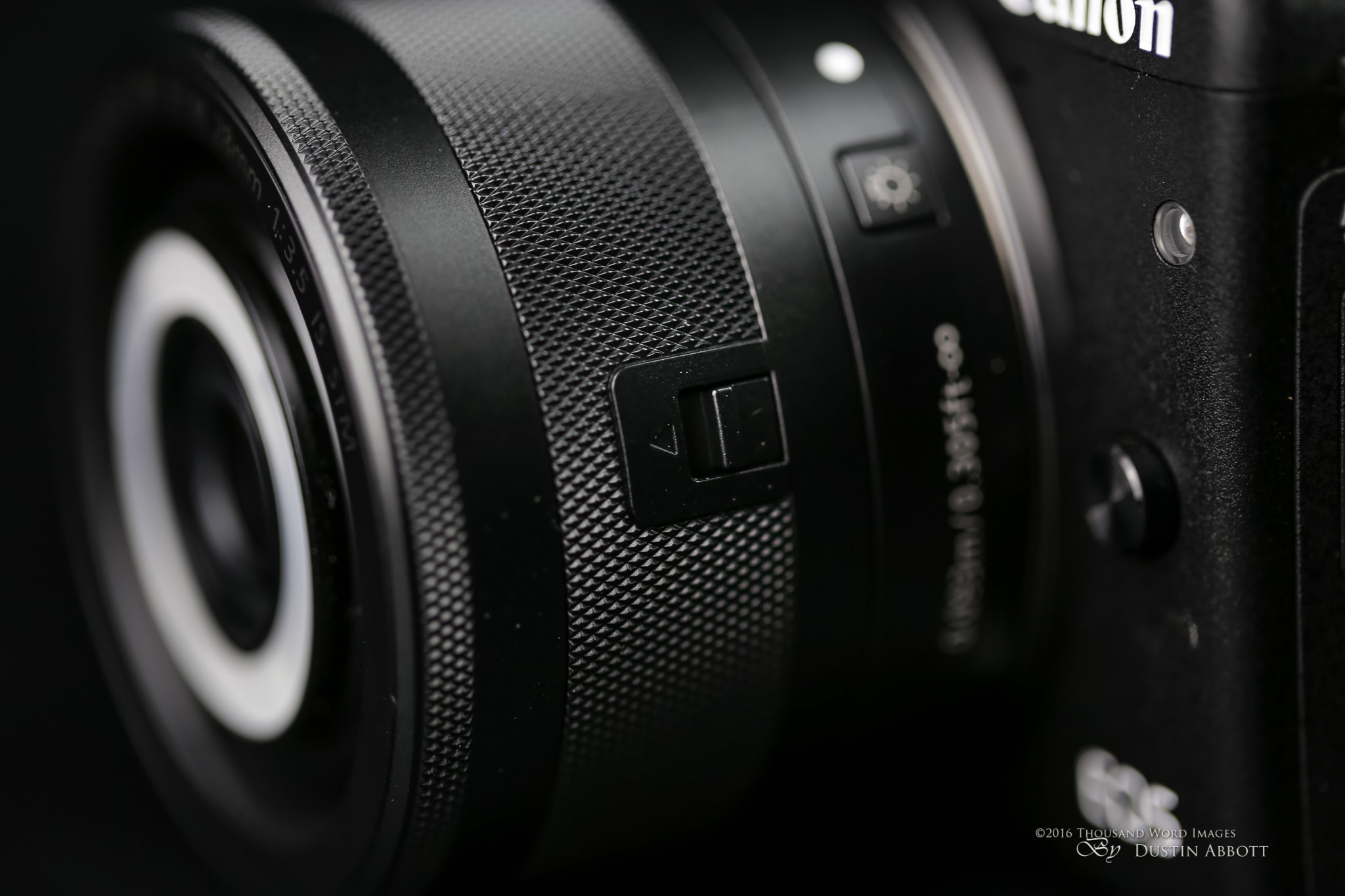
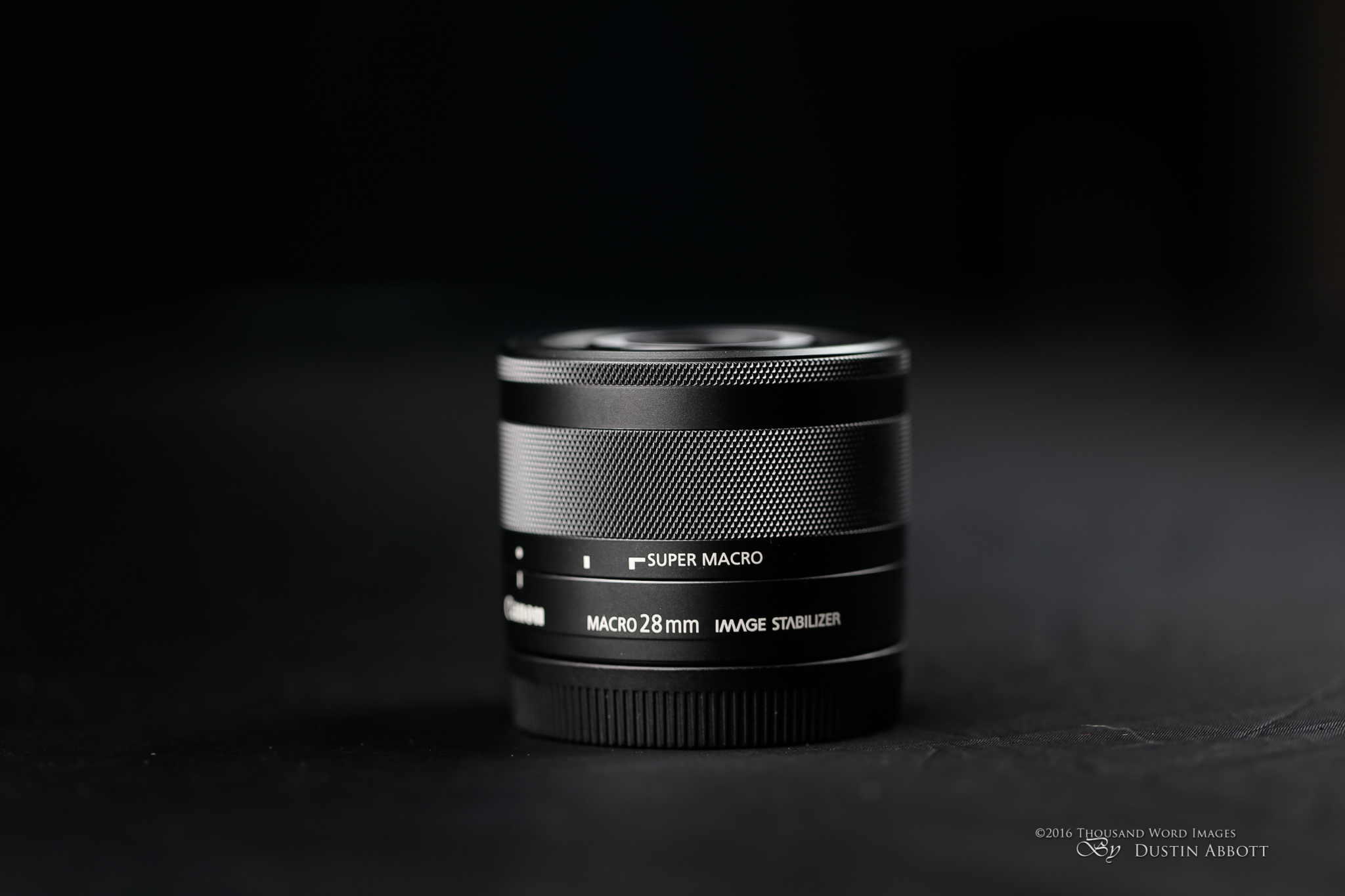
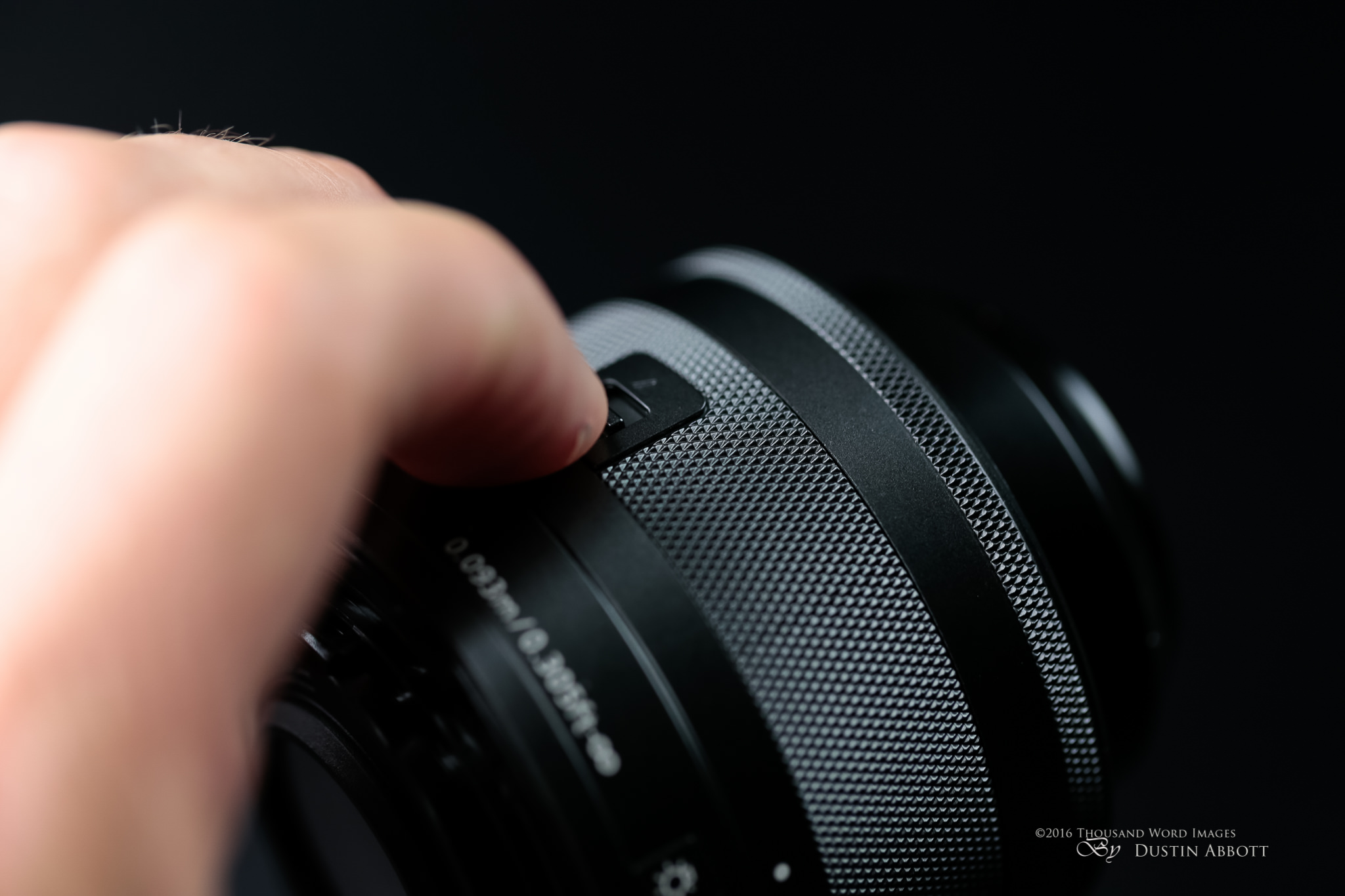
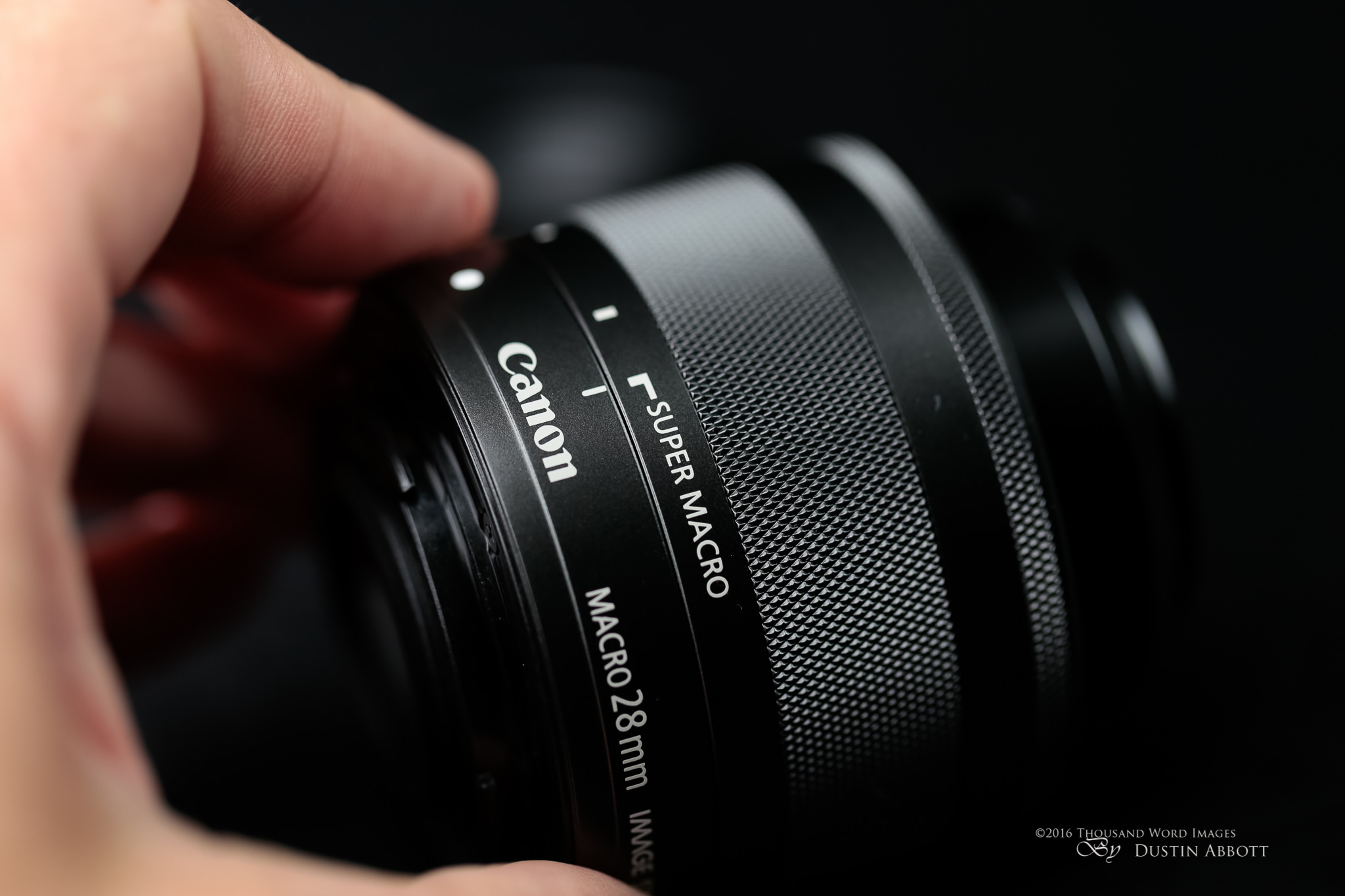
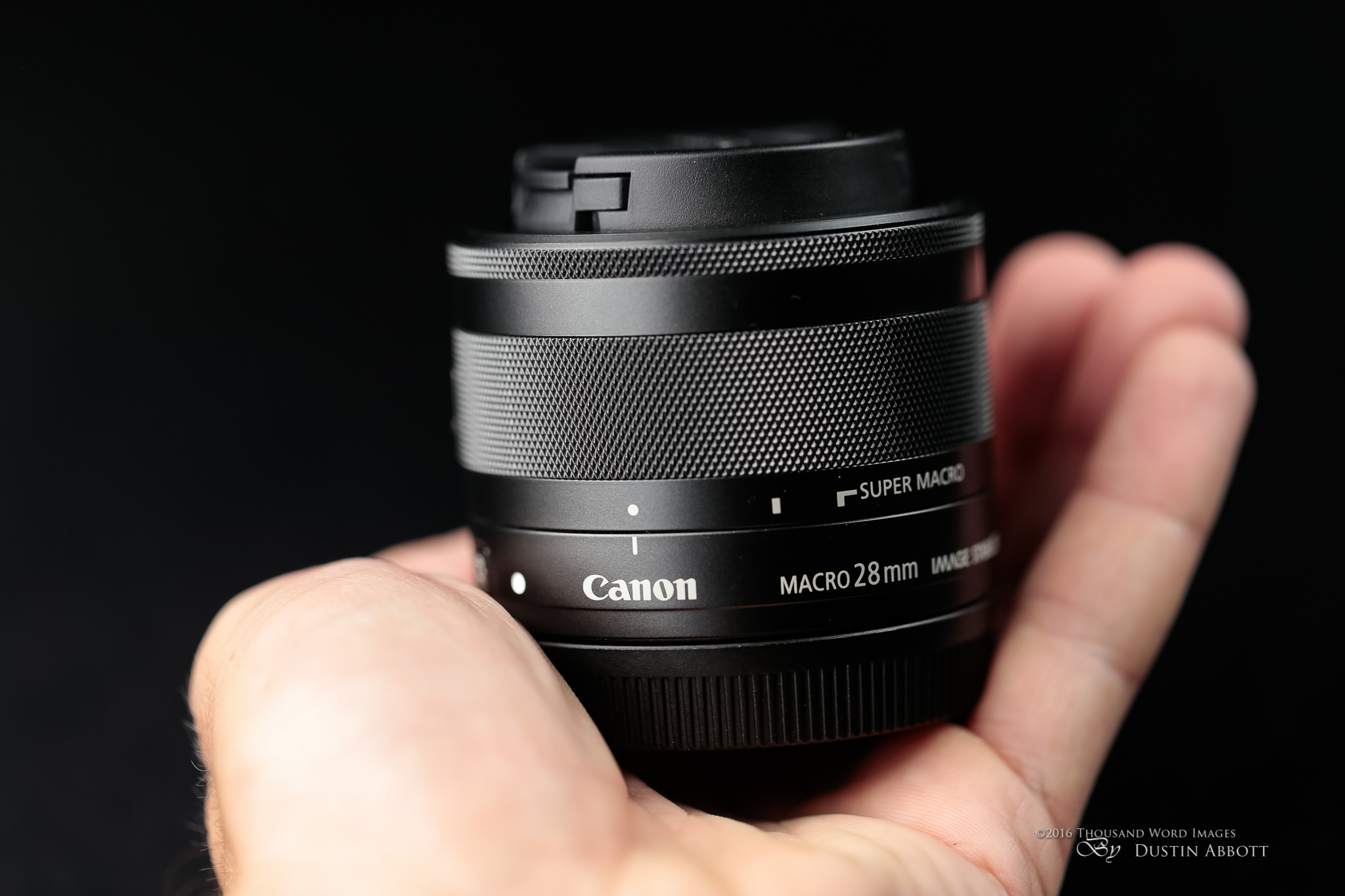
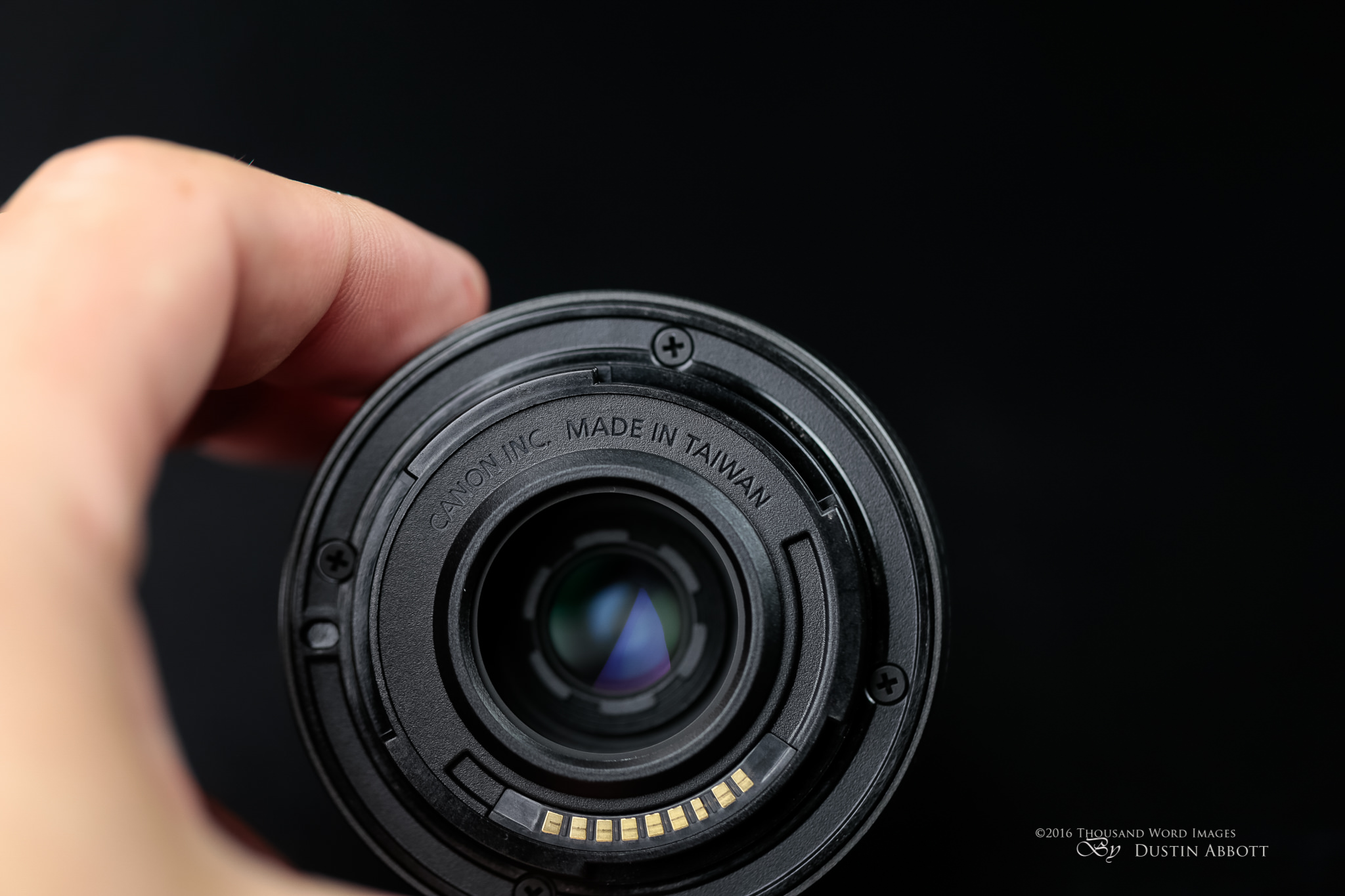





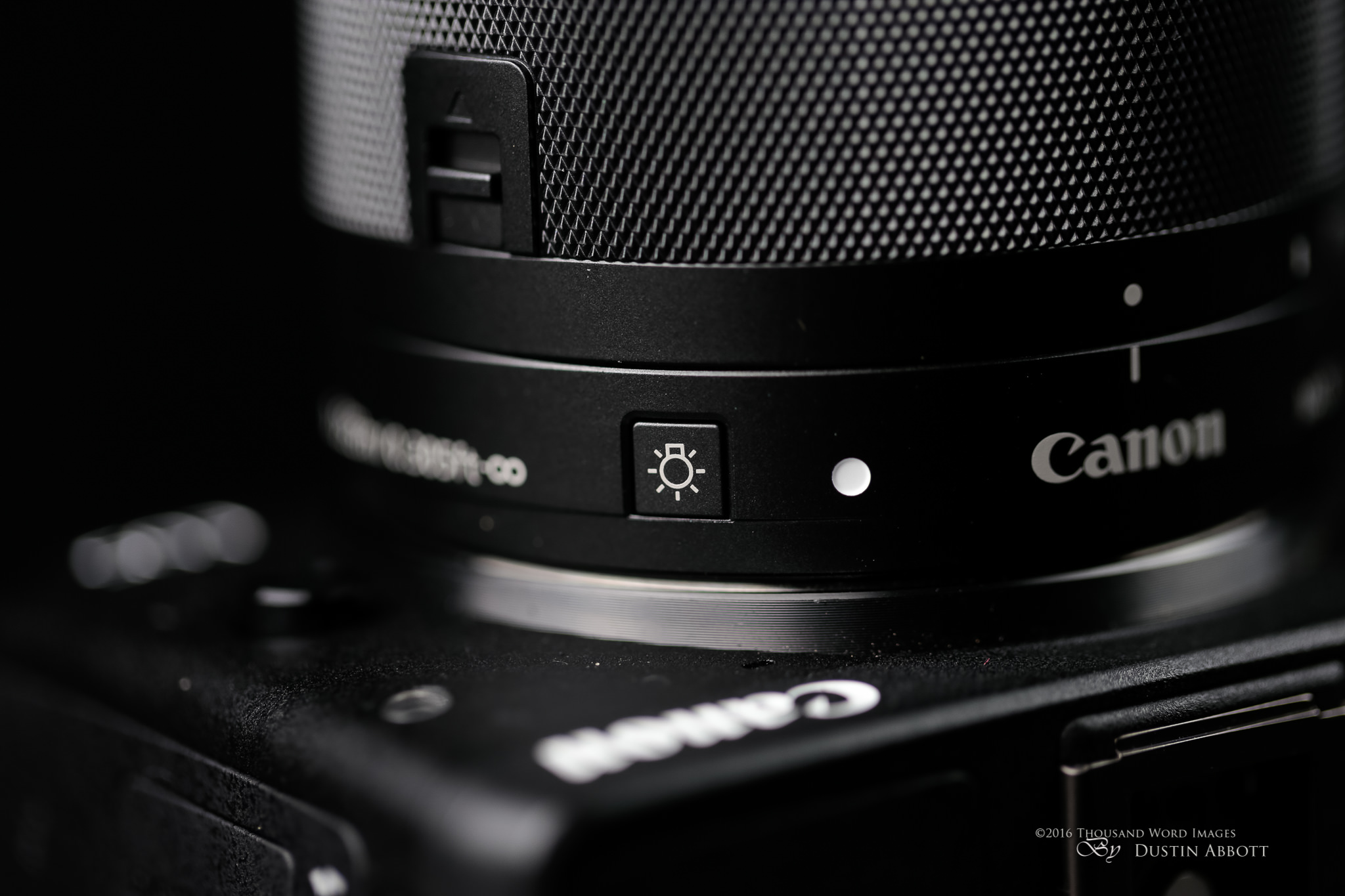
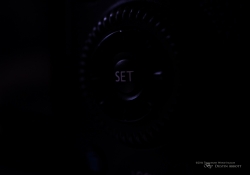
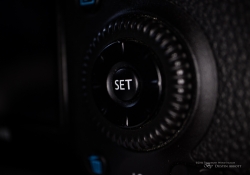
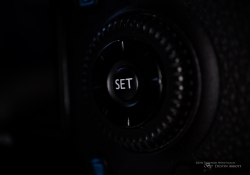

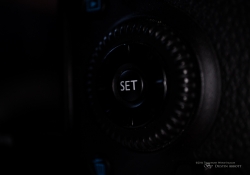

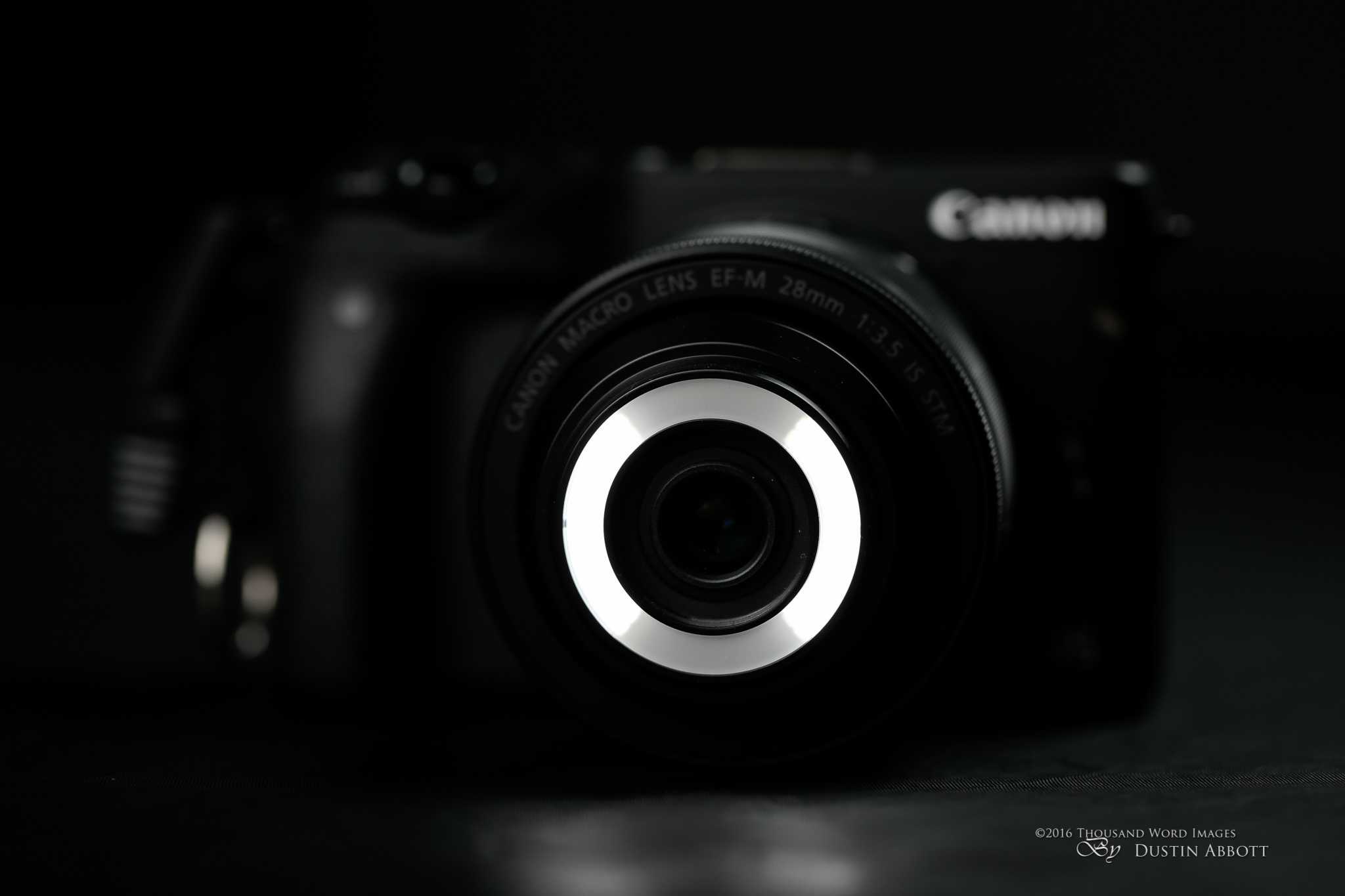
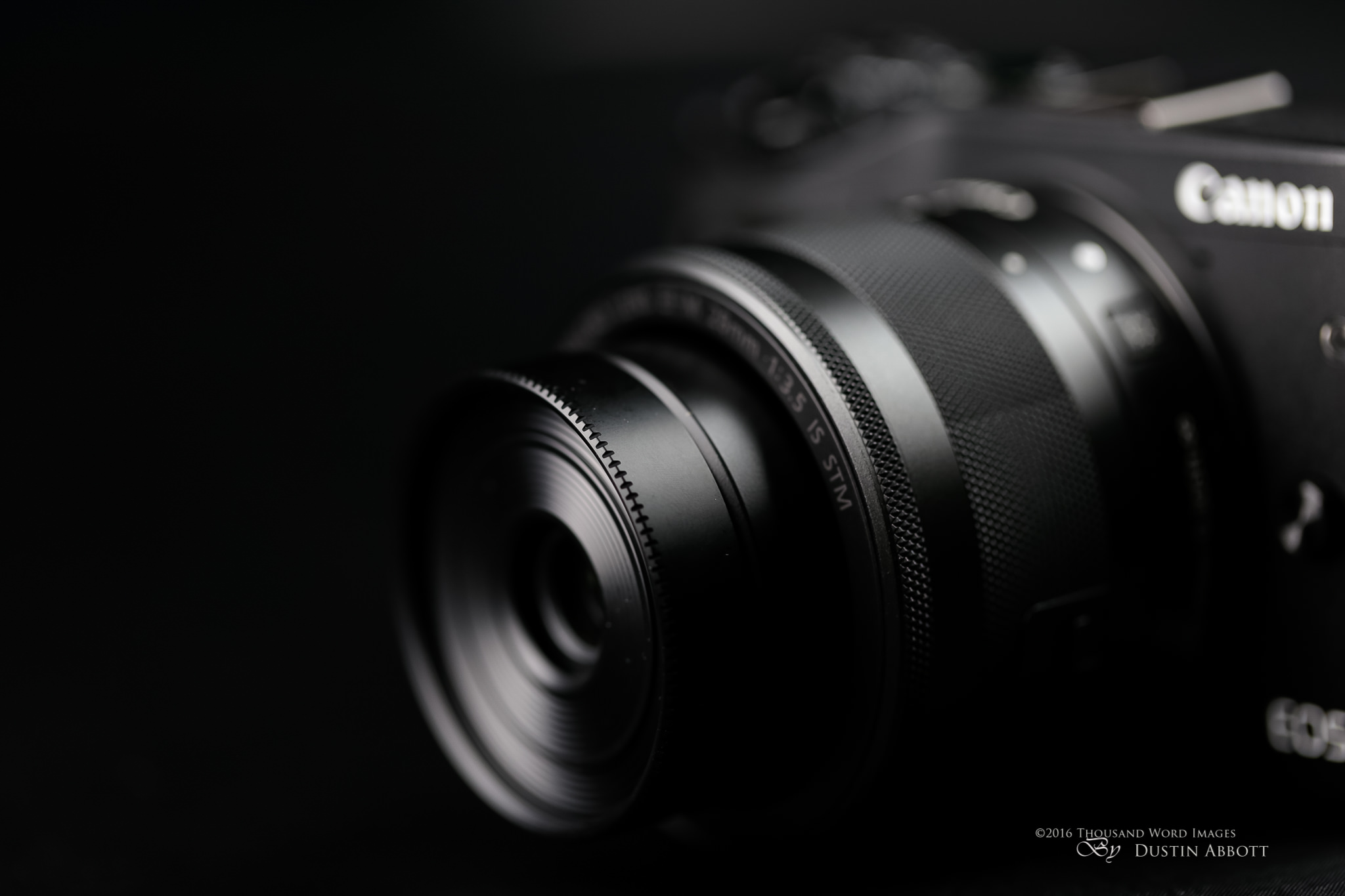


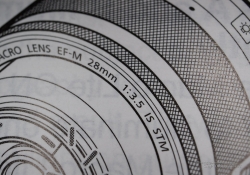

















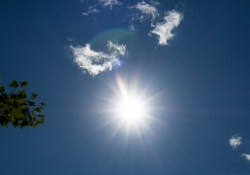










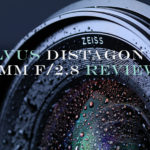

Hi Dustin,
I’m still learning all the capabilities of this lens, but I’m confused by your “chief engineering flaw” as my lens behaves differently. The lens release/lock functions at three positions: when it is collapsed, at shooting position and at super macro. Once you power the camera on and release the lens from its collapsed position you need to move it until the lock engages again at the shooting position. Otherwise the camera keeps telling you to “Set the lens…..” and you cannot get any kind of image. I’m using a recent M3 so maybe there is a software update to go with this lens?
My biggest criticisms are the redundant lock in the super macro position, what is wrong with a normal hard stop, and that this so-called super macro is really not much of an improvement over the 1:1 available in the normal shooting position. A focus limiter would help for normal distances but I bought this lens purely for macro as this is a fairly unique field of view for Canon combined with image stabilization.
Cheers,
Jim
Grayslake, IL
Jim, obviously the mechanics of how we are using it are slightly different. I tend to engage the lock with one hand and quickly twist with the other to prepare for shooting. Unless you very quickly release the switch nothing engages at the normal shooting position, while there is a hard stop at super macro. I naturally go to the hard stop – which is super macro, not normal shooting position.